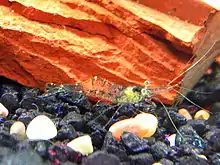Palaemonetes paludosus
Palaemonetes paludosus, known as ghost shrimp, glass shrimp, and eastern grass shrimp,[2][3] is a species of freshwater shrimp from the southeastern United States.
| Palaemonetes paludosus | |
|---|---|
 | |
| P. paludosus in a freshwater aquarium | |
| Scientific classification | |
| Kingdom: | |
| Phylum: | |
| Subphylum: | |
| Class: | |
| Order: | |
| Infraorder: | |
| Family: | |
| Genus: | |
| Species: | P. paludosus |
| Binomial name | |
| Palaemonetes paludosus (Gibbes, 1850) [1] | |
Description
Palaemonetes paludosus is up to 2.5 cm (1.0 in) long and largely transparent. By manipulating the pigment granules in its body, it can produce effective camouflage against its background.[4] It is very similar to P. kadiakensis, from which it can be distinguished by the arrangement of spines on the telson.[3]
Distribution
Palaemonetes paludosus is common in southern states east of the Appalachian Mountains. It is also found in Louisiana, where it may not be native, and there are scattered records from further west, in Texas and California.[3] Their distribution is due to decreased susceptibility to predation because of complexity in higher habitats in Polygonum beds[5]
Ecology
Palaemonetes paludosus lives in fresh water or slightly brackish water, usually in lakes.[3] It is nocturnal, remaining hidden among the vegetation by day, and emerging at night to feed on plankton.[4] It is an important prey item for a number of birds and fishes,[6] and may be considered a keystone species.[7]
References
- "Palaemonetes paludosus (Gibbes, 1850)". Integrated Taxonomic Information System. Retrieved March 28, 2011.
- "Palaemonetes paludosus (riverine grass shrimp)". Animal Diversity Web.
- Jerry G. Walls (2009). "Appendix 2. Freshwater shrimp in Louisiana". Crawfishes of Louisiana. Louisiana State University. pp. 216–224. ISBN 978-0-8071-3409-2.
- Doug Stamm (2008). "Appendix A. More about springs inhabitants". The Springs of Florida (2nd ed.). Pineapple Press. pp. 93–108. ISBN 978-1-56164-422-3.
- Distribution, diel movement, and growth of the grass shrimp Palaemonetes paludosus in the Kissimmee River-floodplain ecosystem,K. J. Wessell (a1), R. W. Merritt (a2) and K. W. Cummins
- John S. Richardson & Michael J. Jackson (2003). "Aquatic invertebrates". In Martin Richard Perrow & Anthony J. Davy (eds.). Handbook of Ecological Restoration, Volume 2. Cambridge University Press. pp. 300–323. ISBN 978-0-521-79128-1.
- Richard W. Merritt; Michael J. Higgins; Kenneth W. Cummins & Brigitte Vandeneeden (1999). "The Kissimmee River–riparian marsh ecosystem, Florida. Seasonal differences in invertebrate functional feeding group relationships". In Darold P. Batzer; Russell Ben Rader & Scott A. Wissinger (eds.). Invertebrates in Freshwater Wetlands of North America: Ecology and Management. John Wiley and Sons. pp. 55–80. ISBN 978-0-471-29258-6.
External links
- C. Baranowski (2011). "Palaemonetes paludosus". Animal Diversity Web. Retrieved April 9, 2011.